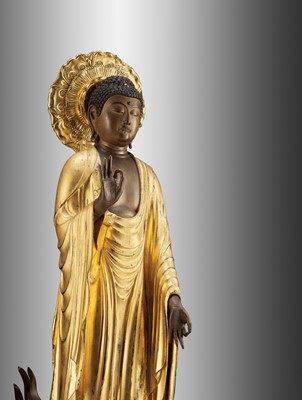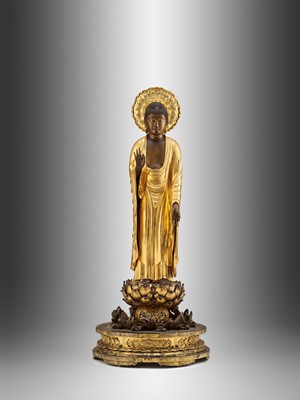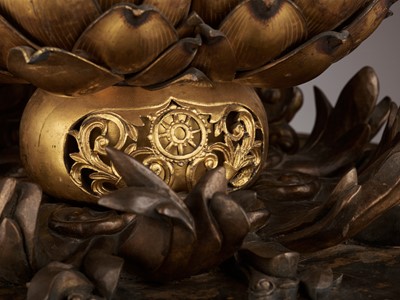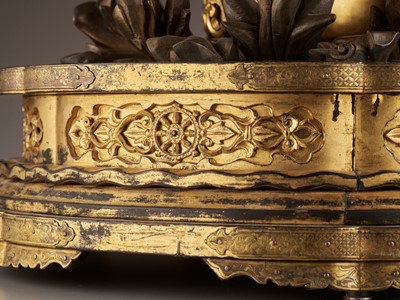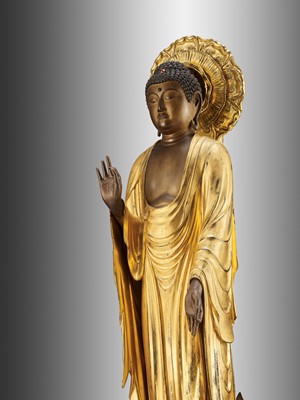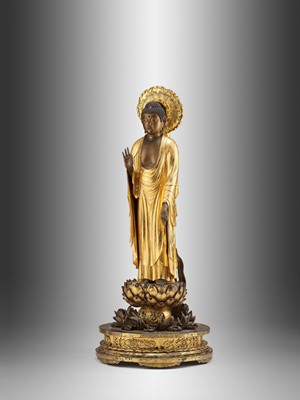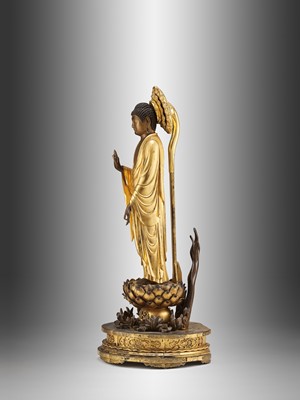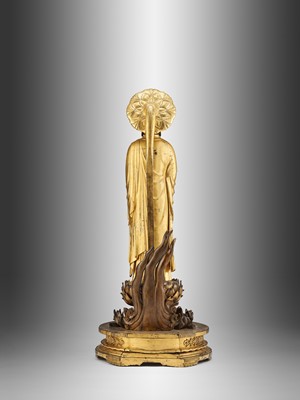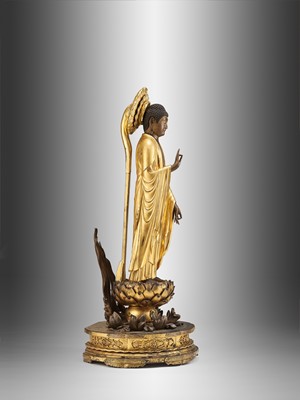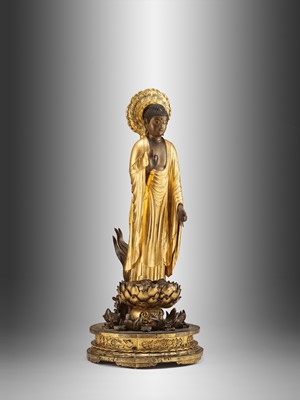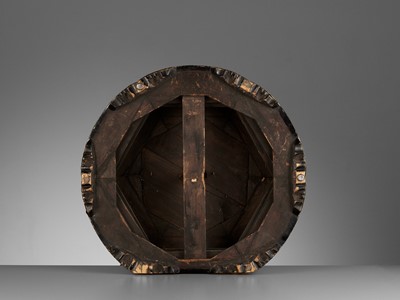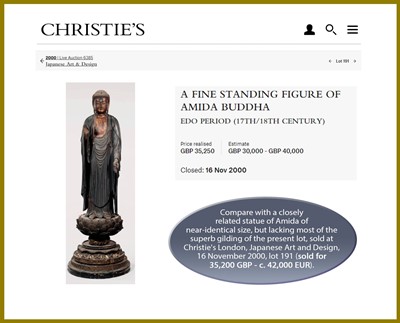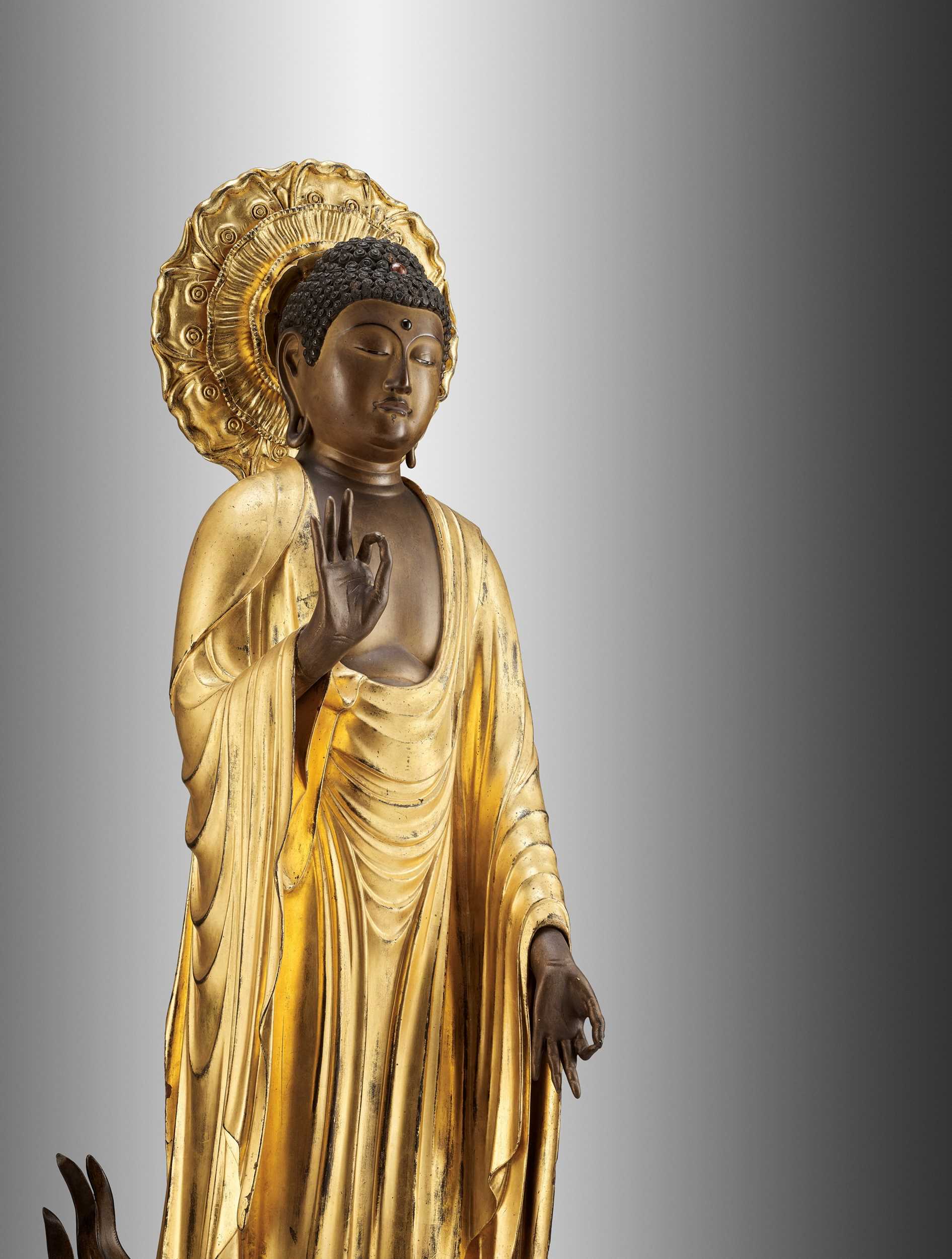4th Jun, 2021 13:00
Fine Japanese Art
127
A MAGNIFICENT AND VERY LARGE FIGURE OF AMIDA, BUDDHA OF INFINITE LIGHT
Sold for €32,864
including Buyer's Premium
Japan, 17th - 18th century, earlier Edo period (1615-1868)
Carved wood. Amida, the Buddha of Immeasurable Light and Life, standing on a lotus base, the right hand raised in the Semui or Vitarka gesture, the left lowered in the Yogan or Varada mudra, the drapery of his garment elegantly rendered in ‘endlessly’ flowing folds, all sumptuously gilt and decorated in fine lacquer.
HEIGHT overall 135 cm
Condition: Traces of use and old wear as expected, minor touchups, age cracks and losses, possibly some old replacements. Generally in good condition, commensurate with age, and better than most statues of this extremely rare size and period.
Provenance: From an old French private collection. Galerie de Chartres, France, April 2016. A noted European collector, acquired from the above.
The Byakugo, a white swirl of fine hair on the forehead of the Buddha, is represented here by a neatly inlaid pearl of crystal. It is also sometimes called the third eye and allows Amida to see past the mundane and into the divine world. The ushnisha above is embedded in finely sculpted, curly hair and neatly inlaid in glass.
The massive, three-sectioned pedestal is composed from multiple layers of finely carved lotus petals and partially reticulated reliefs of Dharmachakra wheels and horizontal Vajras. The borders are fortified by bands of gilt bronze, all bearing fine incision and punching work. The backside shows a group of blazing flames.
The gilt halo is carved in shallow relief to depict a seven-lobed lotus flower springing from a circular band of rays, all supported by a single vertical column.
Amida is the principal Buddha in Pure Land Buddhism, also called the Buddha of Infinite Light. In Vajrayana tradition, he is known for his magnetizing discernment, pure perception and deep awareness of the emptiness of all phenomena. According to scriptures, he possesses infinite merit resulting from good deeds over countless past lives as a bodhisattva.
Literature comparison:
Compare with an earlier statue of a standing Amida Nyorai in the Tokyo National Museum, traditionally identified as Shaka Nyorai, inventory number C21, formerly owned by Sennyu-ji, Kyoto.
Auction comparison:
Compare with a closely related statue of Amida of near-identical size, but lacking most of the superb gilding of the present lot, sold at Christie's London, Japanese Art and Design, 16 November 2000, lot 191 (sold for 35,200 GBP - c. 42,000 EUR).
Japan, 17th - 18th century, earlier Edo period (1615-1868)
Carved wood. Amida, the Buddha of Immeasurable Light and Life, standing on a lotus base, the right hand raised in the Semui or Vitarka gesture, the left lowered in the Yogan or Varada mudra, the drapery of his garment elegantly rendered in ‘endlessly’ flowing folds, all sumptuously gilt and decorated in fine lacquer.
HEIGHT overall 135 cm
Condition: Traces of use and old wear as expected, minor touchups, age cracks and losses, possibly some old replacements. Generally in good condition, commensurate with age, and better than most statues of this extremely rare size and period.
Provenance: From an old French private collection. Galerie de Chartres, France, April 2016. A noted European collector, acquired from the above.
The Byakugo, a white swirl of fine hair on the forehead of the Buddha, is represented here by a neatly inlaid pearl of crystal. It is also sometimes called the third eye and allows Amida to see past the mundane and into the divine world. The ushnisha above is embedded in finely sculpted, curly hair and neatly inlaid in glass.
The massive, three-sectioned pedestal is composed from multiple layers of finely carved lotus petals and partially reticulated reliefs of Dharmachakra wheels and horizontal Vajras. The borders are fortified by bands of gilt bronze, all bearing fine incision and punching work. The backside shows a group of blazing flames.
The gilt halo is carved in shallow relief to depict a seven-lobed lotus flower springing from a circular band of rays, all supported by a single vertical column.
Amida is the principal Buddha in Pure Land Buddhism, also called the Buddha of Infinite Light. In Vajrayana tradition, he is known for his magnetizing discernment, pure perception and deep awareness of the emptiness of all phenomena. According to scriptures, he possesses infinite merit resulting from good deeds over countless past lives as a bodhisattva.
Literature comparison:
Compare with an earlier statue of a standing Amida Nyorai in the Tokyo National Museum, traditionally identified as Shaka Nyorai, inventory number C21, formerly owned by Sennyu-ji, Kyoto.
Auction comparison:
Compare with a closely related statue of Amida of near-identical size, but lacking most of the superb gilding of the present lot, sold at Christie's London, Japanese Art and Design, 16 November 2000, lot 191 (sold for 35,200 GBP - c. 42,000 EUR).
Zacke Live Online Bidding
Our online bidding platform makes it easier than ever to bid in our auctions! When you bid through our website, you can take advantage of our premium buyer's terms without incurring any additional online bidding surcharges.
To bid live online, you'll need to create an online account. Once your account is created and your identity is verified, you can register to bid in an auction up to 12 hours before the auction begins.
Intended Spend and Bid Limits
When you register to bid in an online auction, you will need to share your intended maximum spending budget for the auction. We will then review your intended spend and set a bid limit for you. Once you have pre-registered for a live online auction, you can see your intended spend and bid limit by going to 'Account Settings' and clicking on 'Live Bidding Registrations'.
Your bid limit will be the maximum amount you can bid during the auction. Your bid limit is for the hammer price and is not affected by the buyer’s premium and VAT. For example, if you have a bid limit of €1,000 and place two winning bids for €300 and €200, then you will only be able to bid €500 for the rest of the auction. If you try to place a bid that is higher than €500, you will not be able to do so.
Online Absentee and Telephone Bids
You can now leave absentee and telephone bids on our website!
Absentee Bidding
Once you've created an account and your identity is verified, you can leave your absentee bid directly on the lot page. We will contact you when your bids have been confirmed.
Telephone Bidding
Once you've created an account and your identity is verified, you can leave telephone bids online. We will contact you when your bids have been confirmed.
Classic Absentee and Telephone Bidding Form
You can still submit absentee and telephone bids by email or fax if you prefer. Simply fill out the Absentee Bidding/Telephone bidding form and return it to us by email at office@zacke.at or by fax at +43 (1) 532 04 52 20. You can download the PDF from our Upcoming Auctions page.
How-To Guides
How to Create Your Personal Zacke Account
How to Register to Bid on Zacke Live
How to Leave Absentee Bids Online
How to Leave Telephone Bids Online
中文版本的操作指南
创建新账号
注册Zacke Live在线直播竞拍(免平台费)
缺席投标和电话投标
Third-Party Bidding
We partner with best-in-class third-party partners to make it easy for you to bid online in the channel of your choice. Please note that if you bid with one of our third-party online partners, then there will be a live bidding surcharge on top of your final purchase price. You can find all of our fees here. Here's a full list of our third-party partners:
- 51 Bid Live
- EpaiLive
- ArtFoxLive
- Invaluable
- LiveAuctioneers
- the-saleroom
- lot-tissimo
- Drouot
Please note that we place different auctions on different platforms. For example, in general, we only place Chinese art auctions on 51 Bid Live.
Bidding in Person
You must register to bid in person and will be assigned a paddle at the auction. Please contact us at office@zacke.at or +43 (1) 532 04 52 for the latest local health and safety guidelines.
